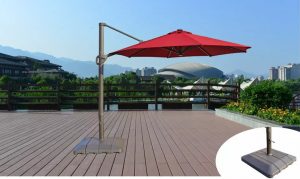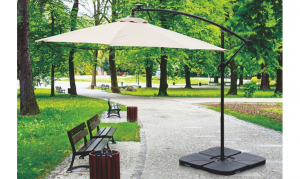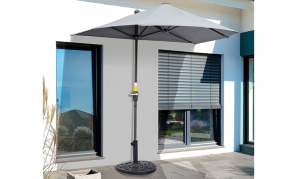More
Shade Solutions: Exploring Different Types of Parasol Base
Shade Solutions: Exploring Different Types of Parasol Base
Introduction:
Choosing the right patio umbrella base is crucial for providing stability and support to your umbrella while enhancing the overall aesthetic of your outdoor space. With a wide variety of options available, it’s essential to understand the different types of patio umbrella bases and their unique features. In this comprehensive guide, we will explore various types of umbrella bases, their benefits, and considerations to help you make an informed decision that suits your specific needs and preferences.
-
Freestanding Umbrella Bases:
Freestanding umbrella bases are the most common and versatile type of base. They typically consist of a sturdy stand with a central pole and a weight compartment. Here are some key features and considerations:
- Material: Freestanding bases are commonly made of materials like cast iron, steel, or plastic. Cast iron bases provide excellent stability, while steel and plastic bases offer lightweight and portable options.
- Weight Capacity: Consider the weight capacity of the base, ensuring it can support the size and weight of your umbrella. Most freestanding bases can accommodate umbrellas with a diameter of up to 11 feet.
- Weighting Options: Freestanding bases often have compartments for adding sandbags, water, or weights to increase stability. Some bases come with pre-installed weights, while others require you to add your own.
-
Offset or Cantilever Umbrella Bases:
Offset or cantilever umbrella bases are designed specifically for offset or cantilever umbrellas, where the umbrella is positioned to the side of the base. Here’s what you should know about these bases:
- Crossbar Design: Offset bases typically have a sturdy crossbar design that provides stability and prevents tipping. The crossbar also allows for easy rotation and adjustment of the umbrella’s position.
- Weight Capacity: Consider the weight capacity of the offset base, ensuring it can support the size and weight of your offset umbrella. Most offset bases can accommodate umbrellas with a diameter of up to 13 feet.
- Offset Range: Check the offset range of the base, which determines how far the umbrella can extend to provide maximum shade coverage. Look for bases with a wide offset range to suit your desired seating or lounging arrangement.
-
Table-Insert Umbrella Bases:
Table-insert umbrella bases are designed to be placed inside a patio table with an umbrella hole. These bases provide stability and support while freeing up valuable space on the ground. Consider the following features:
- Compatibility: Ensure the base is compatible with the size and design of your patio table’s umbrella hole. Measure the diameter of the umbrella hole and choose a base that fits securely.
- Material and Weight: Table-insert bases are often made of heavy materials like cast iron or steel to provide stability. Consider the weight of the base to ensure it can support the umbrella without tipping over.
- Height Adjustment: Some table-insert bases offer height adjustment options, allowing you to raise or lower the umbrella to your desired height.
-
In-Ground Umbrella Bases:
In-ground umbrella bases are permanently installed in the ground or a solid surface, providing a secure and stable foundation for your umbrella. Here are some considerations for in-ground bases:
- Installation: In-ground bases require digging a hole and securely anchoring the base into the ground or a concrete surface. Professional installation may be recommended for optimal stability.
- Stability: In-ground bases offer the highest level of stability, making them suitable for areas with high wind conditions. They eliminate the risk of tipping or shifting that can occur with freestanding bases.
- Fixed Position: Keep in mind that in-ground bases provide a fixed position for your umbrella. Consider the placement carefully to ensure maximum shade coverage and compatibility with your outdoor layout.
Conclusion:
Selecting the right patio umbrella base is essential for providing stability and enhancing the functionality and aesthetics of your outdoor space. Whether you opt for a freestanding base, offset base, table-insert base, or in-ground base, consider factors such as material, weight capacity, and compatibility with your umbrella. By understanding the different types of bases and their unique features, you can make an informed decision that suits your needs and ensures long-lasting enjoyment of your patio umbrella.













